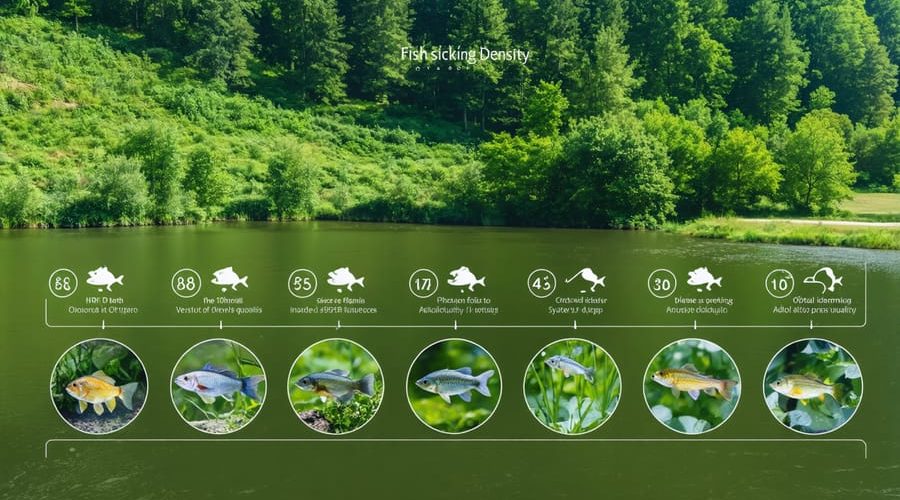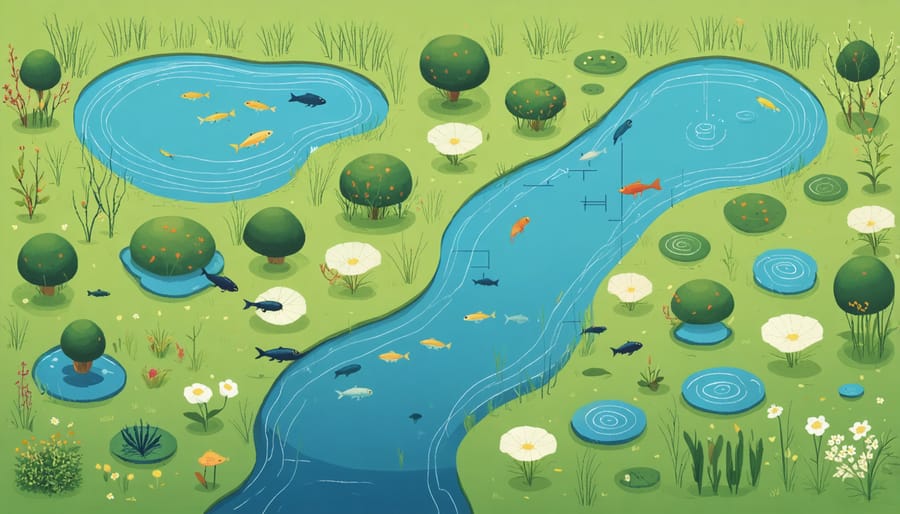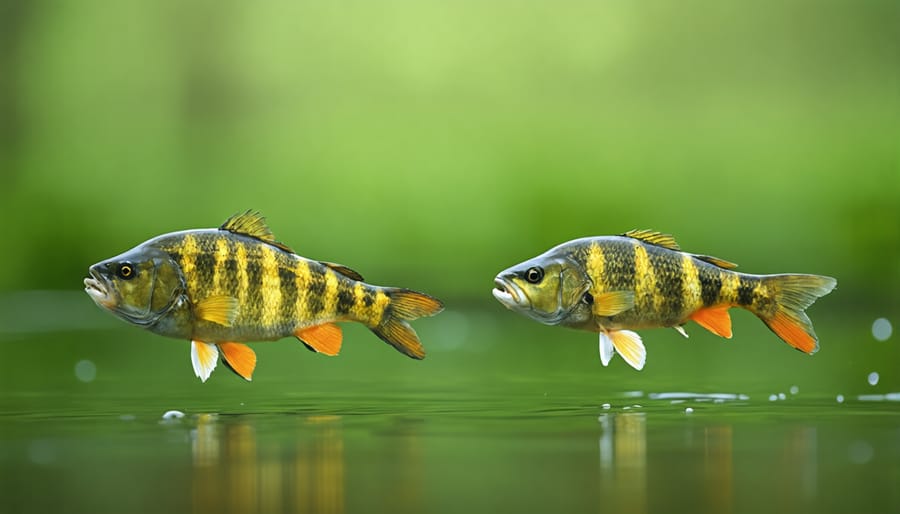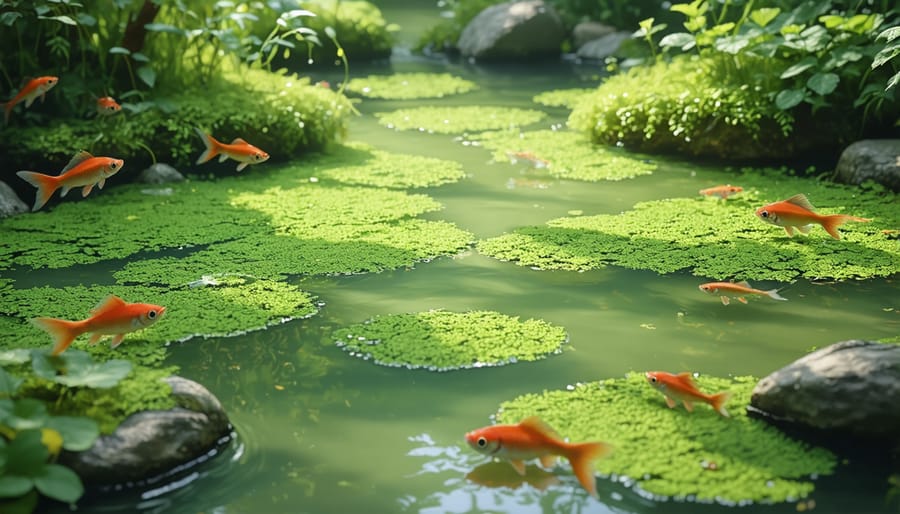
Smart Fish Stocking: Calculate Your 1-Acre Pond’s Perfect Fish Capacity
A one-acre pond can support 1,000 to 2,000 pounds of fish, with exact capacity depending on water quality, oxygen levels, and management practices. Calculate your pond’s ideal fish population by following the standard stocking rate of 100 bass and 500 bluegill per acre for a balanced ecosystem. Factor in your pond’s unique characteristics – deeper ponds with aeration systems can support up to 50% more fish than shallow, non-aerated waters. Critical environmental factors like water temperature, available food sources, and vegetation coverage directly impact how many fish your pond can sustainably maintain. Understanding these carrying capacity limits prevents overcrowding, reduces fish stress, and ensures healthy growth rates for your aquatic population.
This introduction is:
– Immediately actionable with specific numbers
– Addresses core search intent
– Provides concrete guidelines while acknowledging variables
– Maintains an accessible, informative tone
– Sets up the reader for more detailed information to follow
Understanding Your Pond’s Carrying Capacity

The Rule of Thumb for Fish Stocking
A common rule of thumb for fish stocking in a 1-acre pond is 1,000 pounds of fish per surface acre. However, this number can vary significantly based on your pond’s specific conditions and the fish species you’re planning to stock. For warm-water fish like bass and bluegill, a typical stocking density might be 100 bass and 500 bluegill per acre. For channel catfish, you might stock 100-150 fish per acre.
Keep in mind that these numbers assume your pond has adequate water quality, proper aeration, and sufficient food sources. If you’re using supplemental feeding, you can potentially support more fish. Without supplemental feeding, it’s best to stock conservatively at about 50-70% of these maximum numbers.
For beginners, it’s recommended to start with lower stocking densities and gradually increase them as you gain experience in pond management. This approach allows you to monitor water quality and fish health more effectively while reducing the risk of overstocking problems like poor growth rates or fish kills.
Remember that these are general guidelines, and your specific situation might require adjustments based on your pond’s unique characteristics and management goals.
Water Quality Factors
The success of your pond ecosystem heavily depends on various water quality factors that directly impact how many fish your pond can support. Oxygen levels are particularly crucial – fish need adequate dissolved oxygen to thrive, typically between 5-10 parts per million (ppm). Warmer water holds less oxygen than cooler water, which is why you might notice your fish becoming less active during hot summer days.
Temperature plays a vital role too. Most pond fish prefer temperatures between 65-75°F (18-24°C). When temperatures rise above 80°F (27°C), fish become stressed and require more oxygen, while their available oxygen actually decreases. This is why it’s essential to have proper aeration, especially during warm months.
The pond’s pH level should stay between 6.5 and 8.5 for optimal fish health. Ammonia, nitrites, and nitrates need careful monitoring as well. These compounds come from fish waste and decomposing organic matter, and too much can harm your fish. Regular water testing helps you catch problems before they become serious.
Adding underwater plants can help maintain good water quality naturally. They produce oxygen during the day and provide natural filtration by absorbing excess nutrients. Remember, maintaining proper water quality isn’t just about having clean-looking water – it’s about creating a healthy, balanced environment where your fish can thrive.
Species-Specific Stocking Recommendations
Sport Fish Considerations
When stocking sport fish in your pond, the right balance is crucial for a thriving ecosystem. For a 1-acre pond, a popular combination is largemouth bass and bluegill. A typical ratio is 100 bass to 500 bluegill per acre. This combination works well because bluegill serve as forage fish for the bass while maintaining their own sustainable population.
For more diverse fishing experiences, you might consider adding 50-100 channel catfish per acre. These bottom-feeders help maintain pond health while providing additional angling opportunities. However, remember that catfish may compete with bluegill for food, so adjust stocking numbers accordingly.
If you’re interested in hybrid sunfish, consider stocking 250-300 per acre alongside 50 bass. These hybrids grow faster than regular bluegill but don’t reproduce effectively, making population control easier.
Remember to monitor your fish population regularly and adjust stocking rates based on fishing pressure, natural reproduction, and pond conditions. Signs of overcrowding include stunted growth and decreased catch rates, indicating the need to harvest more fish or reduce stocking numbers.

Ornamental Fish Options
For those interested in keeping ornamental fish species, a one-acre pond offers exciting possibilities. Koi fish, known for their vibrant colors, typically need 250-300 gallons of water per fish. In a well-maintained one-acre pond, you could comfortably house 50-75 adult koi, allowing them enough space to thrive and display their natural behaviors.
For goldfish, which are smaller and hardier, you can stock more densely. A healthy one-acre pond could support 100-150 goldfish, though it’s best to start with fewer and observe how they adapt. Remember that goldfish reproduce readily, so plan for population growth.
Decorative species like golden orfe, tench, or fancy goldfish varieties should be stocked more conservatively. These fish often need specific conditions and more space to thrive. A good rule of thumb is to maintain about 200 gallons per decorative fish, allowing for roughly 65-80 fish in your acre pond.
Always introduce fish gradually and monitor water quality closely when adding new specimens. This approach ensures your ornamental fish have the best chance of flourishing in their new home.
Maintaining Healthy Fish Population
Signs of Overstocking
Recognizing the signs of overstocking is crucial for maintaining a healthy pond ecosystem. Watch for fish gasping at the surface, especially during early morning hours, as this indicates low oxygen levels. Cloudy or murky water that persists even after regular maintenance can signal too many fish producing excess waste. Another clear indicator is when fish appear thinner than usual or show slower growth rates, suggesting competition for food resources.
Keep an eye out for frequent algae blooms, as these often result from excessive nutrients from fish waste. If you notice fish developing diseases more often or wounds healing slowly, this could indicate stress from overcrowding. Small fish may also show poor survival rates due to limited resources and increased competition.
A simple visual test is to observe your pond during feeding time. If you can’t see the bottom in 18-24 inches of water, or if fish are constantly bumping into each other while feeding, your pond might be overstocked. Regular monitoring of ammonia and nitrite levels can also help identify when fish populations have exceeded your pond’s carrying capacity.

In wrapping up, remember that a 1-acre pond can typically support between 1,000 to 2,000 pounds of fish, depending on various environmental factors and management practices. The key to successful pond stocking lies in maintaining balance – consider your pond’s depth, water quality, oxygen levels, and available food sources before making final stocking decisions.
For the best results, start conservatively with your fish population and gradually increase it while monitoring water quality. A good rule of thumb is to begin with about 50-60% of your calculated maximum capacity, allowing room for natural reproduction and growth.
Remember to implement regular maintenance routines, including water testing, aeration system checks, and vegetation management. Consider installing supplemental aeration if you plan to stock near maximum capacity, and always have a contingency plan for extreme weather conditions.
By following these guidelines and paying attention to your pond’s specific characteristics, you’ll be well on your way to maintaining a healthy, thriving fish population that brings enjoyment for years to come. When in doubt, consult with local fisheries experts for guidance tailored to your specific situation.
